What are the ten benefits of Vajrayogini practice? Why is her practice recommended in our busy, terrifying times?
Why do many Buddhist teachers describe Vajrayogini as the one practice for our busy, hectic, terrifying times which can lead us, in one lifetime, to Enlightenment? Why is Vajrayogini the Sarva Buddha Dakini — the Dakini who is the...

Why do many Buddhist teachers describe Vajrayogini as the one practice for our busy, hectic, terrifying times which can lead us, in one lifetime, to Enlightenment? Why is Vajrayogini the Sarva Buddha Dakini — the Dakini who is the essence of all the Buddhas and Dakinis? What are the ten benefits of her practice? How can we practice Vajrayogini now, if we don’t yet have the empowerment and permission of a teacher? We answer these questions, and more, in this feature on the Bliss Queen, fully Enlightened Vajrayogini.
Special Note: This month (December 24 2022 to January 2023) is Vajrayogini’s special month. For a feature on her special month, see>>
January 17, 2023 is also the annual Vajrayogini Day!>>
Announcement: We are producing a documentary on the benefits of Vajrayogini practice, releasing soon.
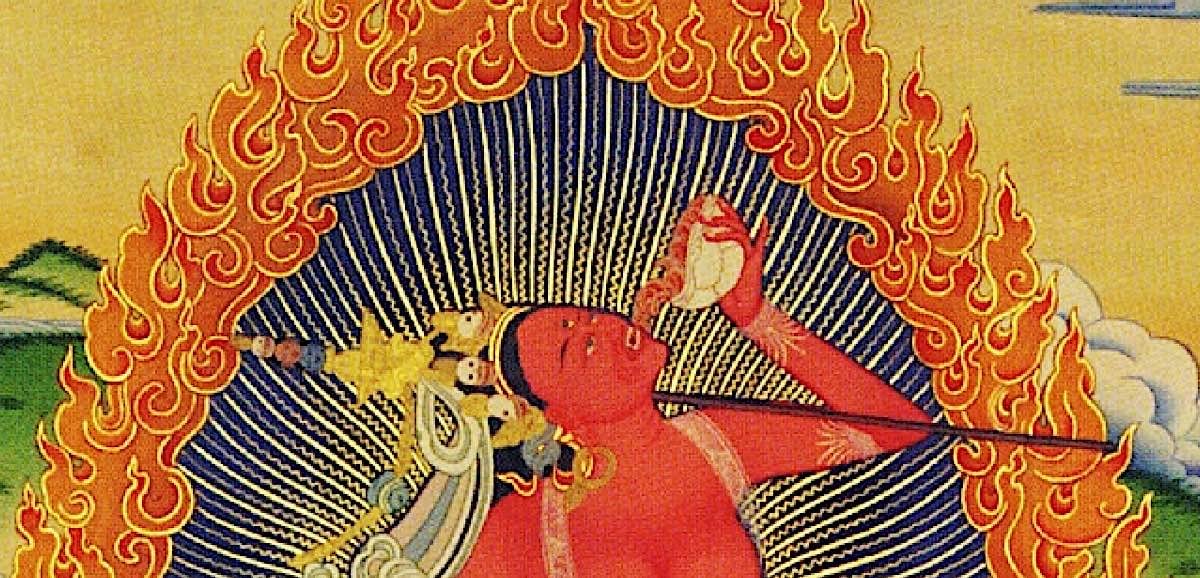 Close detail Vajrayogini Narokacho on an old thangka.
Close detail Vajrayogini Narokacho on an old thangka.
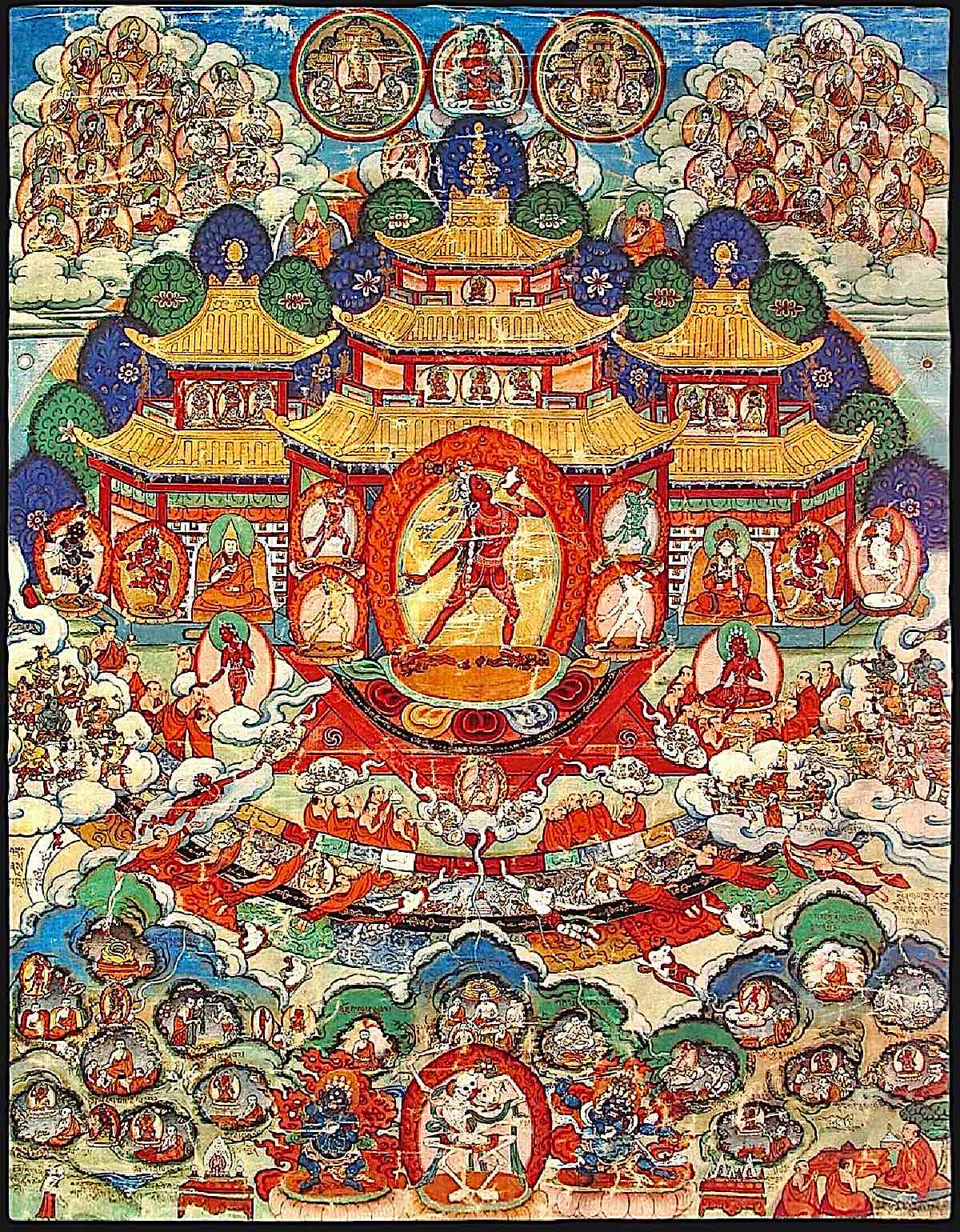 A thangka illustrating all the 11 Yogas of Naropa. These 11 Yogas are central to Vajrayogini’s complete path to Enlightenment.
A thangka illustrating all the 11 Yogas of Naropa. These 11 Yogas are central to Vajrayogini’s complete path to Enlightenment.Stories of Vajrayogini’s miracles
There are many stories of Vajrayogini and Her devotees. One of the most touching is the story of Kusali, a novice monk who was very devout in the practice of Vajrayogini. When walking along the shore of the Ganges river with his Guru and his entourage, they met an old leper woman in severe pain who desperately wanted to cross the river.
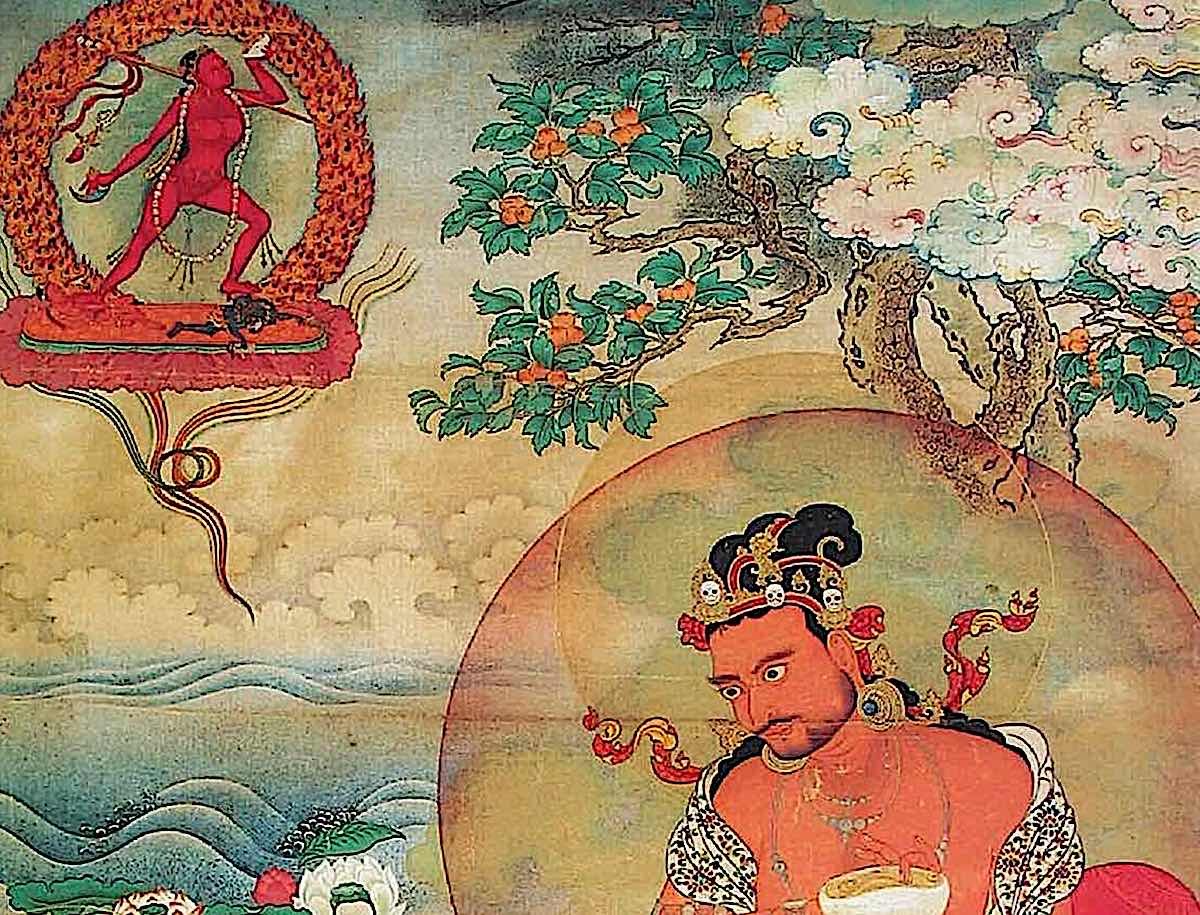 The great Mahasiddha Naropa has a vision of Vajrayogini.
The great Mahasiddha Naropa has a vision of Vajrayogini.The Guru walked past the leper, stepping around her. The other monks also avoided her cries.
But, Kusali was so moved by her pain, that he bound her on his back with his own garments and started to cross the river. Miraculously, before they reached the halfway mark, the leper transformed into glorious Vajrayogini and he found himself flying up out of the water. Kusali’s guru and the other monks — who practiced Vajrayogini, but had not stirred the compassion for the leper woman — could only stare up in shock.
Vajrayogini carried him in that very instant to her Dakini Land, in recognition of his compassion and devout practice.
As the “highest” of the highest yoga practices in Buddhism, the actual practice and mantra of Nacho Kacho Vajrayogini does require the permission from a teacher and empowerment to self-visualize or chant the supreme mantra. You cannot chant the mantra or visualize yourself as the Queen of the Dakinis until you have empowerment and permission — but making offerings and meditating on an image or frontal generation can create merit for future teachings from a qualified teacher.
 Vajrayogini and Green Tara can be thought of as two aspects of the Wisdom Female Buddha.
Vajrayogini and Green Tara can be thought of as two aspects of the Wisdom Female Buddha.
Since Vajrayogini is the Highest Yoga Tantra emanation of Tara, many devout Buddhists practice Tara — which requires no permission — until they have an opportunity for Varayogini practices.
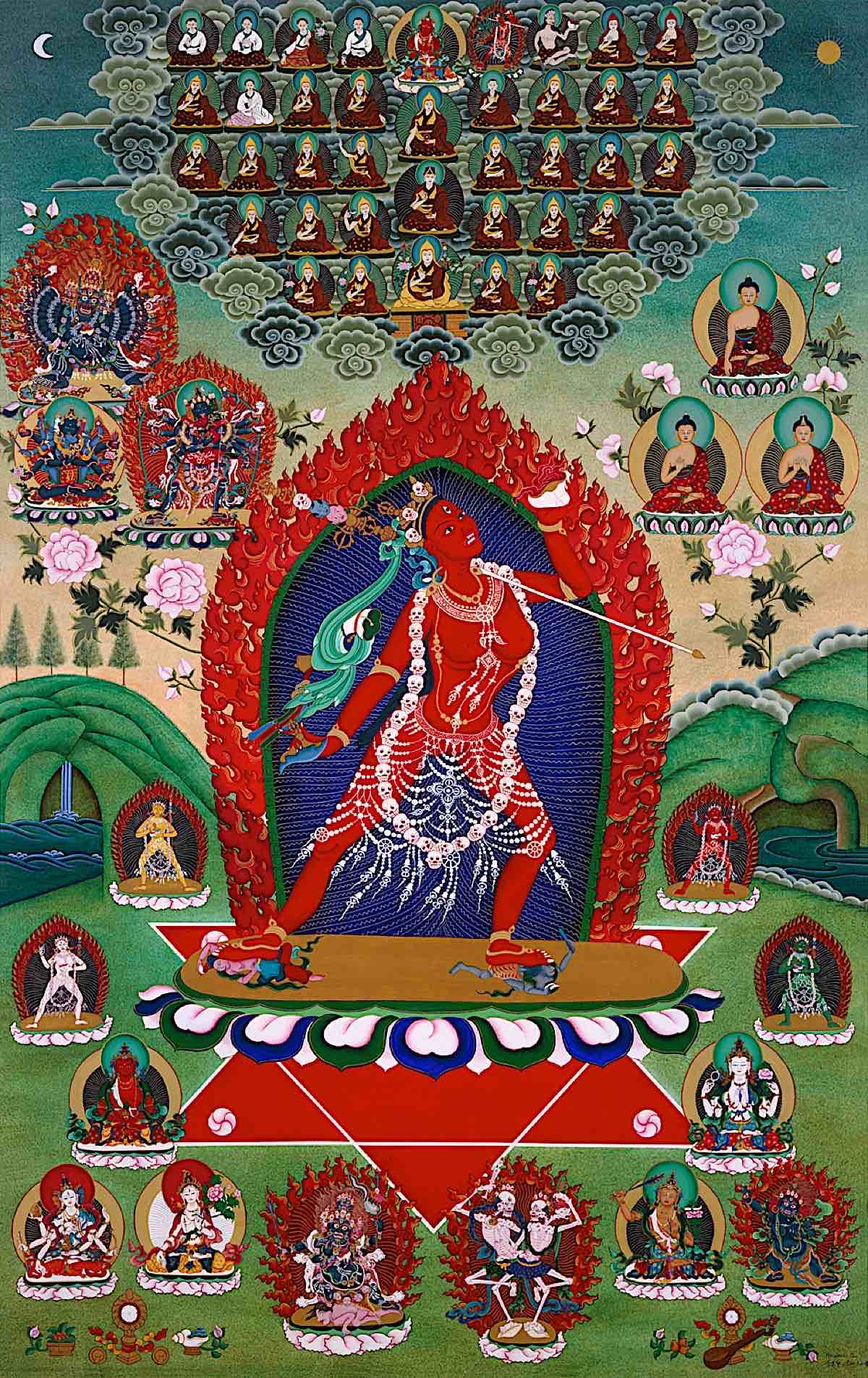 An elaborate and stunning painting of the entire merit field of Vajrayogini Naro Kacho (Gelug and Sakya lineage). At the top are the Gurus of the lineage, with Vajradharma in the center top, Vajrayogini herself (who first taught the tantra). To the left top are the three Highest Yoga Tantra deities of the Gelug tradition — Yamantaka, Chakrasamvara in union with Vajrayogini, and Ghuyasamaya. Surrounding her Tetrahedron mandala (the six-pointed star) are the wisdom Dakinis, as well as Avalokiteshvara. Bottom left are the three long-life practice deities (Amtiyus, Ushnishavijaya and White Tara)
An elaborate and stunning painting of the entire merit field of Vajrayogini Naro Kacho (Gelug and Sakya lineage). At the top are the Gurus of the lineage, with Vajradharma in the center top, Vajrayogini herself (who first taught the tantra). To the left top are the three Highest Yoga Tantra deities of the Gelug tradition — Yamantaka, Chakrasamvara in union with Vajrayogini, and Ghuyasamaya. Surrounding her Tetrahedron mandala (the six-pointed star) are the wisdom Dakinis, as well as Avalokiteshvara. Bottom left are the three long-life practice deities (Amtiyus, Ushnishavijaya and White Tara)
Why is Vajrayogini the Buddha for modern times?
Increasingly, modern life is almost too hectic for deep yogic practices that can lead to Enlightenment in one lifetime. Today, most of us do not have the luxury of retiring to a cave for hermetic practice over many years. Although all Buddhist practices potentially can lead to Enlightenment in one lifetime, Vajrayogini practice — above all others — is the one recommended by teachers for modern times.
Why?
Clarity and simplicity. Brevity — yet acomprehensive practice. Easy — yet advanced. Her visualization is not difficult even for those who have trouble with visualizations. Her practice is complete — containing all the 11 Yogas required to generate the enlightened mind — yet can be accomplished in an astonishingly brief period of time. Her practice doesn’t require “retiring from the world” — in fact, it is encouraged to use our “daily lives” as an opportunity to practice. One of the 11 Yogas is the Yoga of Daily Activities. Another is the Yoga of Sleeping. There is even the Yoga of Awakening. And the Yoga of Tasting Nectar — which we can combine with our morning breakfast. In other words, our daily, modern lives become the practice!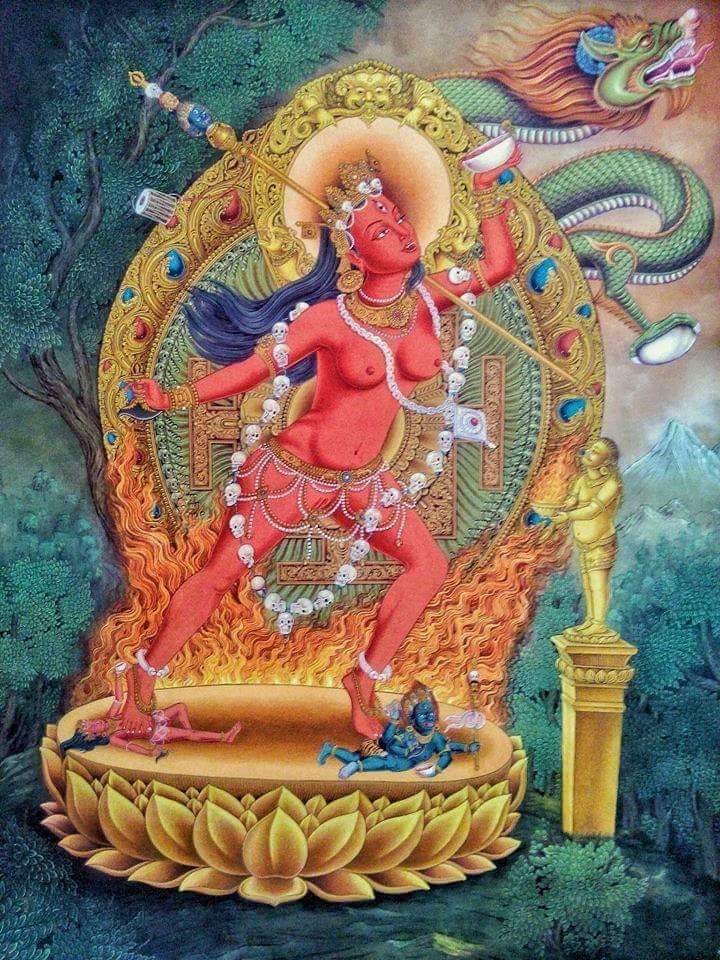
The ten benefits of Vajrayogini practice are relevant in modern times
The ten benefits of Vajrayogini practice are also highly appropriate in modern times. Whether you are concerned with the suffering of daily life, the stress of “making a living” or even health issues, Vajrayogini practice is helpful in these practical ways. It is also the ultimate advanced practice — a complete path to Enlightenment exemplified in the 11 Yogas of Vajrayogini. Vajrayogini is also central to Chod practices.
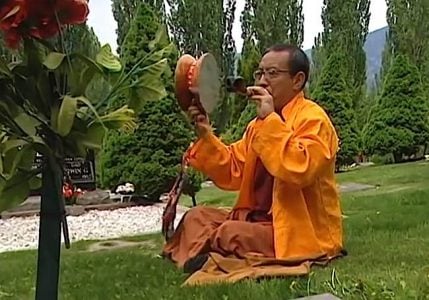 Advanced teachings, such as Chod, and other Vajrayana practices, require a teacher due to the precise, delicate and powerful nature of their impact on the mindstream. In this picture, Zasep Tulku Rinpoche practicing ancient Chod in a traditional cemetary, to benefit all sentient beings. For a feature on Chod, see>>
Advanced teachings, such as Chod, and other Vajrayana practices, require a teacher due to the precise, delicate and powerful nature of their impact on the mindstream. In this picture, Zasep Tulku Rinpoche practicing ancient Chod in a traditional cemetary, to benefit all sentient beings. For a feature on Chod, see>>
First, to clarify, these benefits are for all sentient beings with a karmic connection to Vajrayogini. It is not a practice only for women, or men. Vajrayogini is a female Dakini — whose essence is Enlightened Wisdom. Yet the main lineages of Vajrayogini were taught by both women and men. Both women and men can attain the ten benefits through the Vajrayogini practice.
It is, however, a practice for the serious practitioner. Not only is a Highest Yoga Tantra, it is a Mother Tantra. The practice may be concise and relatively easy, but it requires commitment, a teacher and a lifetime of practice.
Why is her practice so profound, despite it’s simplicity? Harvard Scholar and author Miranda Shaw, Ph.D. explains:
 Miranda Shaw, Ph.D. Buddhist scholar and author.
Miranda Shaw, Ph.D. Buddhist scholar and author.“She is inarguably the supreme deity of the Tantric pantheon. No male Buddha, including her divine consort, Heruka Cakrasamvara, approaches her in metaphysical or practical import.” [1]
Ten benefits of her practice
Why do so so many aspire to her practice, even though she is the Highest Yoga Tantra meditational practice? The simplicity of her practice, combined with the all-encompassing benefits of her practice make it a worthwhile goal — to build enough merit and foundation to ask permission of a teacher to engage in this modern practice.
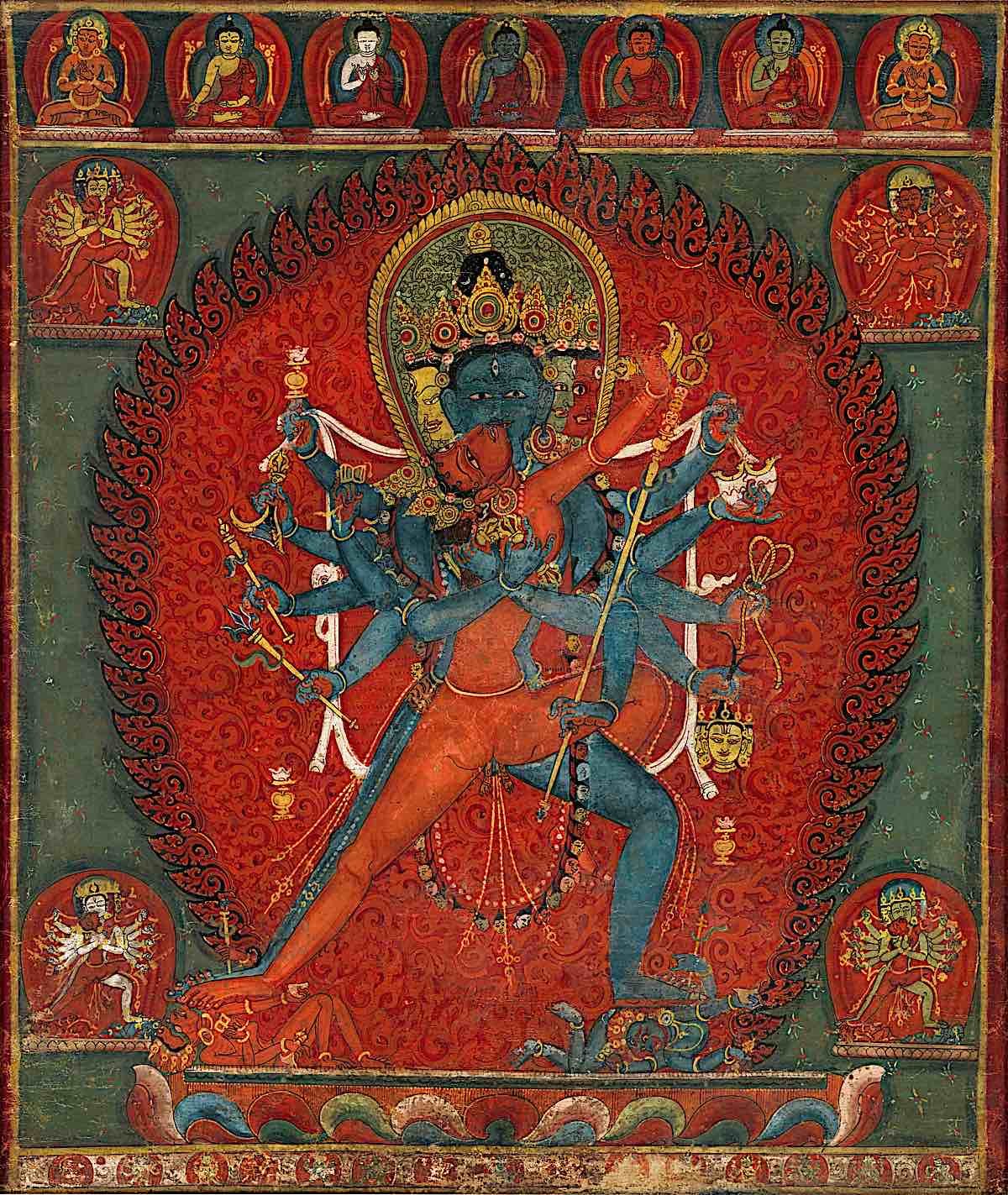 The Highest Yoga practice of Vajrayogini is found in chapter 48 of the Chakrasamvara Heruka Root Tantra. Vajrayogini practice has all the benefits of Chakrasamvara practice, without the complexity of practice and visualization. She is the Wisdom consort of Chakrasamvara. Since Wisdom and Compassion must always be in union, even in the solitary Vajrayogini practice he is symbolically present in the form of her Katvanga staff. Pictured An ancient thangka of Vajrayogini in union with Chakrsasamvara.
The Highest Yoga practice of Vajrayogini is found in chapter 48 of the Chakrasamvara Heruka Root Tantra. Vajrayogini practice has all the benefits of Chakrasamvara practice, without the complexity of practice and visualization. She is the Wisdom consort of Chakrasamvara. Since Wisdom and Compassion must always be in union, even in the solitary Vajrayogini practice he is symbolically present in the form of her Katvanga staff. Pictured An ancient thangka of Vajrayogini in union with Chakrsasamvara.The source Tantra — the Condensed Root Tantra of Heruka — explains there are ten key spiritual benefits to practice, many not available from other practices:
Easy to practice: although a Highest Yoga Tantra practice, the visualizations of the mandala are “relatively” easy, the sadhanas are “relatively” short and the mantra is “relatively” easy. This is all despite the fact that it contains all of the practices and benefits of Chakrasamvara’s practice — without the complex visualizations and practices. Ideal for this “degenerate” age: Unlike other practices, Vajrayogini brings fast benefits, since Heruka and Her mandalas are still present in our world. Other deities do not have mandalas in our physical world. By tradition, this means, Her practice is fast. The Dakinis of her mandala are near us at all times. Vajrayogini’s mantra is supreme for attainments. Although somewhat long at 32 syllables, it is easy to memorize. It is said that Vajrayogi’s mantra alone is all a practitioner would ever need, provided they have faith, including for the powerful blessings listed in the next benefit. Also, the thirty-two syllables represent the 32 Dakinis of her mandala and their helpful activities. Powerful blessings: not just blessings, but quick blessings. And, not just the uncommon Siddhis (accomplishments) such as “realizations” but also the common or mundane blessings of the five powers: pacifying, increasing, empowering, wrathful, and, enlightened activities. In other words, everything from healing, to auspicious merit and good fortune, to accomplishing important mundane activities. Can accomplish all attainments: many of the great Mahasiddas accomplished Enlightenment and other realizations from Her practice. Can practice both the generation and completion stages together: Unlike most other practices, which require perfection of generation stage practice prior to engaging in completion stage, with Vajrayogini you are shown how to do both together. If you don’t know what this means, teacher guidance is best. Overcomes attachments: Vajrayogini’s sensuous nature and red colour signify she is suitable for overcoming desires and cutting attachments (hence, her flaying knife!) Contains all other practices: Although a short practice, Vajrayogini’s practice contains the essence of ALL practices.There are also two relatively more secret (due to complexity) benefits; in other words benefits that aren’t easily understood unless you are already a practitioner and have full instruction. We won’t explain them here, since they are too profound as topics to cover here, but we list them for reference:
Uncommon Yoga of Inconceivability Special body mandala practiceFinally, this is the supreme of the Mother Tantras, which focus on Enlightenment through practices focused on clear light and bliss.
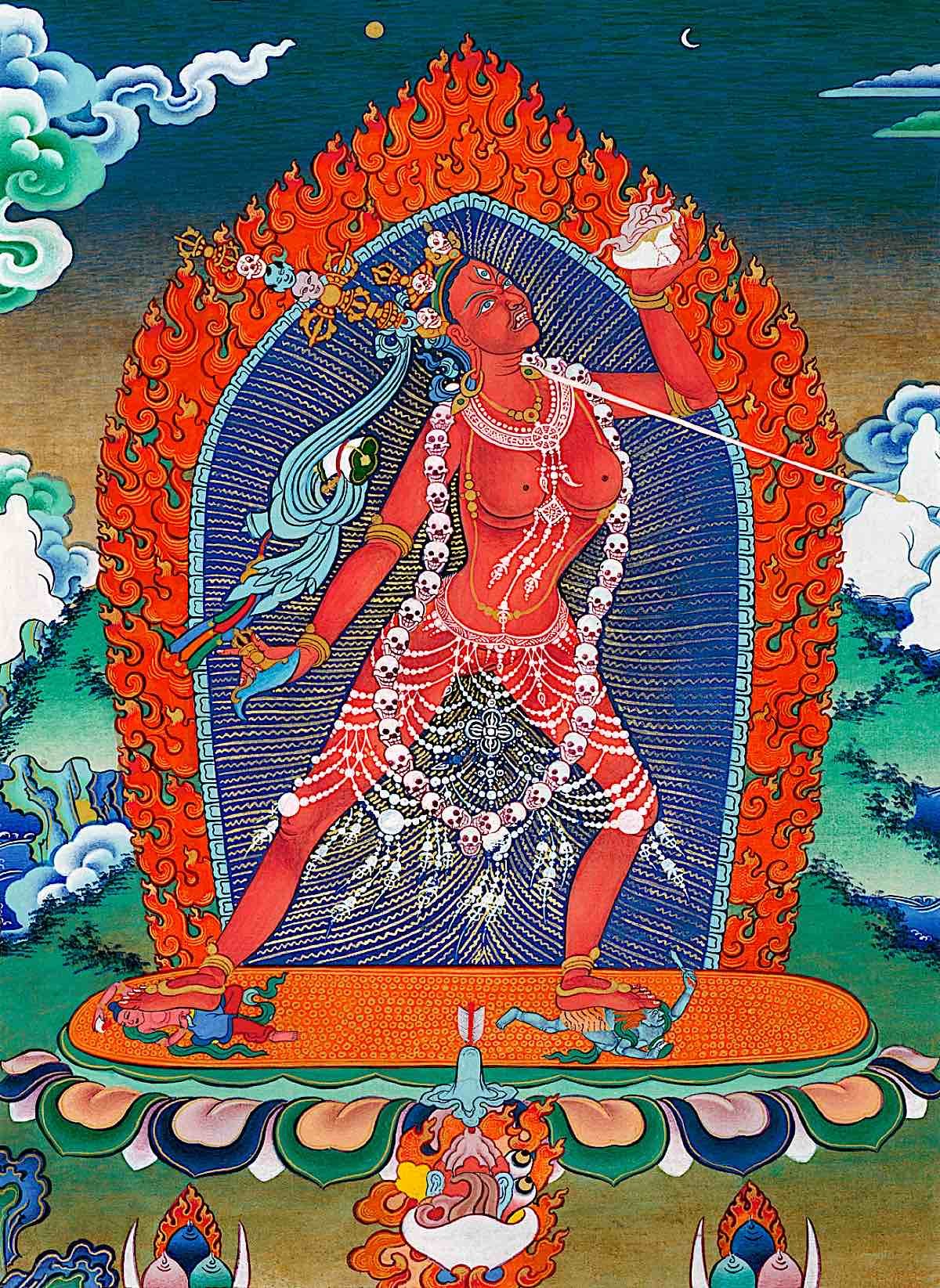
Her symbolism is not for the timid; no, she’s not a vampire
Those not accustomed to the higher yogic practices may be shocked by Vajrayogini’s visualized appearance.
As beautiful as she is, she is naked. She has fangs, like a western movie vampire. What is that all about? She wears skulls and bone ornaments. She has a skullcup in her hand filled with nectar which is blood. She carries a “flaying knife” in her other hand — a traditional curved knife used to “flay” the corpses. She stands on two people — who are actually mundane or worldly gods. Her mandala includes eight “charnal” grounds or cemetaries.
There is no doubt the visual metaphors are symbols of great power — but how do they connote the Enlightened activities of a Buddha?
Unlike typical, serene Buddha images — such as Shakyamuni, the five Dhyani Buddhas, Avalokiteshvara or Tara — she is dancing, not sitting. She’s a dervish of activity. Her eyes aren’t half-closed in contemplation — they are fully open, all three of them, and looking up towards Her Pureland of Kechara — sometimes pronounced Keajra — or Dakini land (“Kacho” translates as Dakini.)
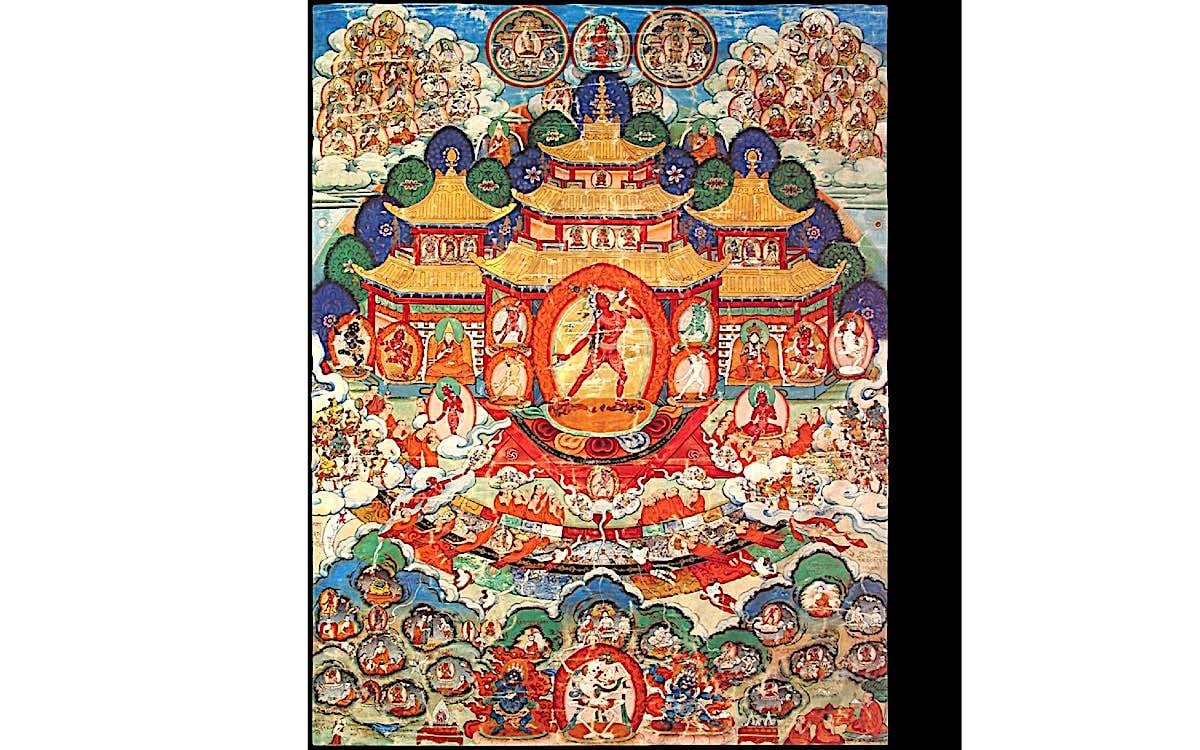 An ancient thangka illustrating the Pureland of Vajrayogini. Practicing her yogas is the sure path to rebirth in this Pureland.
An ancient thangka illustrating the Pureland of Vajrayogini. Practicing her yogas is the sure path to rebirth in this Pureland.
Symbolism step-by-step
While there may be reassuring messages in the peaceful lotus posture of most Buddhist deities, there is unquestionably a great power conveyed in Vajrayogini’s image. Her symbolism is high-impact, in-your-face, and activity-oriented.
Red. Wisdom Dakini’s can be of any color, although Vajrayogini is usually red, the color of the Padma family of Amitabha Buddha and the West. The Padma family represents “speech” — the most important aspect of Dharma. Red and the Padma family represent the element of fire (tummo in terms of the inner body) and transform our passions with discriminating wisdom.
Naked. Why is she naked? This symbolizes she dances on “Emptiness” in blissful awareness.
Surrounded by Wisdom Fire. Her radiant red body blazing with yogic fire and surrounded by the flames of wisdom.
Two bodies. She dances on two prone bodies, a male and a female. This signals her power to suppress our egos and attachments. As these two figures are two worldly gods, this signifies the power of the Enlightened mind to transcend Samsara.
Fifty skulls. Around her neck are fifty skulls. These symbolize the fifty sacred Sanskrit letters. It is through language that Dharma has the power to transmit teachings and helps us to overcome Samsara. This also symbolizes the ultimate power of the mantra.
Fangs. What about those vampire fangs? Actually, she has four sharp fangs, symbolizing the overcoming of the four poisons that trap us in Samsara.
Flaying knife. That savage-looking curved blade — typically visualized as made of meteoric metal — symbolizes her power to cut through our desires, ignorance and attachments through ultimate wisdom.
Skullcup with inner offerings (nectar of blood and organs). This one’s gruesome right? Not only a skull but blood and organs? This is to signify the overcoming or transformation of death and impermanence through clear light and bliss — and through ultimate wisdom. It also signifies that the ultimate offering we can make to Vajrayogini is none other than ourselves and our practice.
Double Tetrahedron Phenomenon Source. What is that? (Hint: it looks like a six-pointed star.) Her palace, unlike other mandalas, is a double Tetrahedron — two triangles that look like a six-pointed star, except it is three-dimensional, ending in a sharp point. This is symbolic of all manifested and unmanifested phenomena — and makes the mandala visualization very simple, at least versus the complex palace mandalas of other visualizations.
Eight cemeteries. The eight charnel grounds, full of zombies and corpses, surround her mandala, and symbolize she has the power to overcome the eight poisons and obstacles that obscure our path to realization and ultimate Enlightenment. These are:
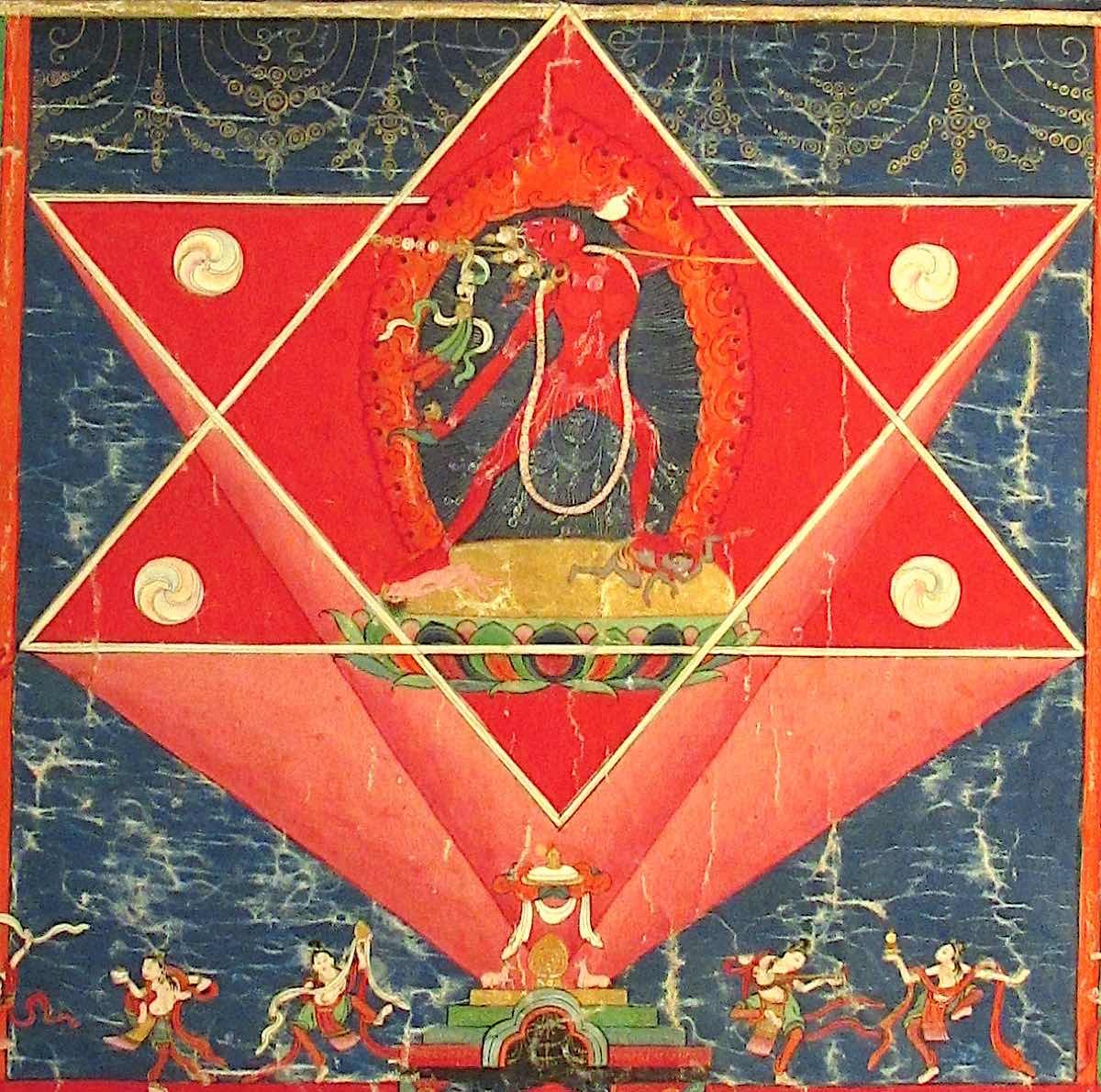 The mandala of Vajrayogini is very easy to visualize as compared to more complex Highest Yoga visualizations of most other practices. The Double Tetrahedron, as depicted here, is actually three-dimensional.
The mandala of Vajrayogini is very easy to visualize as compared to more complex Highest Yoga visualizations of most other practices. The Double Tetrahedron, as depicted here, is actually three-dimensional.
How to practice if you do not yet have empowerment?
As with all aspirational practices, you can start by making “frontal” offerings to the deity of your aspiration — in this case Vajrayogini. Set up a picture or a statue. Place offerings in front of her — simple or elaborate as you are able. Light daily incense, and take refuge in front of your image.
Recitation of the Eight lines or praise to Vajrayogini, the Mother is often recommended to plant the karmic seeds for her practice. (See full text below.)
Pray and request you will develop sufficient merit and karma to have an opportunity to receive empowerment, instruction, and permission in the future. One prayer you can practice daily is:
“May there be the auspiciousness of swiftly receiving the blessings Of the hosts of glorious, sacred gurus,Vajradhara, Pandit Naropa, and so forth. The glorious lords of all virtue and excellence. May there be the auspiciousness of the Dakini truth body, Perfection of wisdom, the supreme Mother of the Conquerors, the natural clear light, free from elaboration from the beginning, the lady who emanates and gathers all things stable and moving. May there be the auspiciousness of the complete enjoyment body, simultaneously born. A body radiant and beautiful. Ablaze with the glory of the major and minor marks. A speech proclaiming the supreme vehicle with sixty melodies. And a mind of non-conceptual bliss and clarity, possessing the five exalted Wisdoms. May there be the auspiciousness of the emanation body, born from the places, Dakinis who with various form bodies, in various places, fulfill by various means the aims of various ones to be tamed in accordance with their various wishes. May there be the auspiciousness of the supreme Dakini, mantra-born. A venerable lady with a color similar to that of a ruby, with a smiling, wrathful manner, one face, two hands holding a curved knife and skull-cup and two legs in bent and outstretched positions. May there be the auspiciousness of your countless millions of emanations and the hosts of the seventy-two thousand dakinis. Eliminating all the obstructions of practitioners. And bestowing the attainments that are longed for.”
Of course, one of the attainments to wish for, at this stage, if you do not have empowerment would be to receive teachings and permission.
Meanwhile, of course, fulfill any current commitments you have for practices you’ve already received. Finally, dedicate the merit of your offerings to the cause for Enlightenment for all beings — and also for the cause of receiving Vajrayogini instruction and permission in the future.
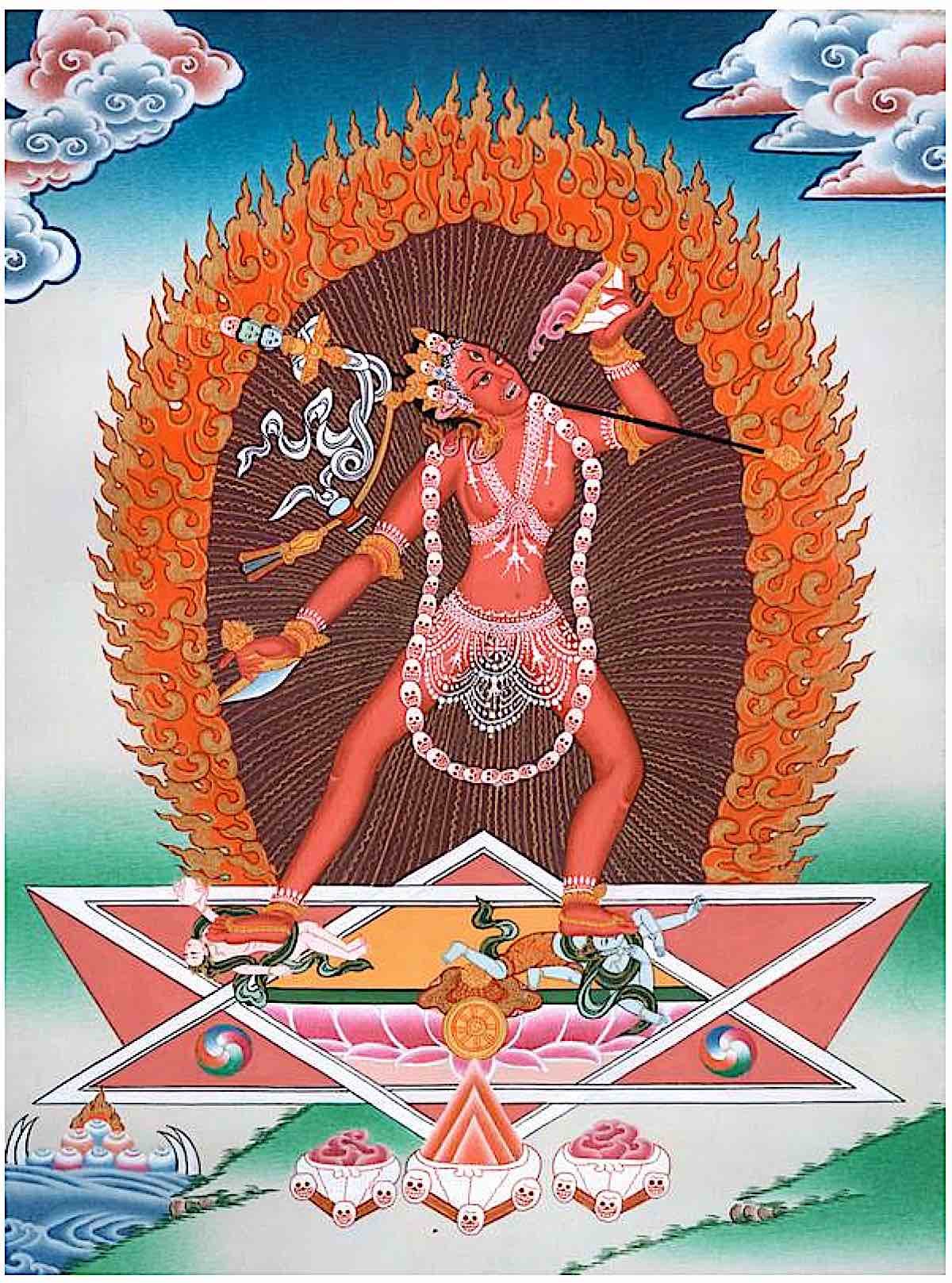
The Eight Lines of Praise to Vajrayogini
Widely published are the eight lines of praise to Vajrayogini, the Mother, usually chanted in Sanskrit. As Vajrayogini and the Dakinis are usually associated with the evening, the best time for a daily recitation of Her prasie is the evening. These, unlike the mantra, are not generally considered restricted, although be guided by your own teacher:
oṃ nama āryaparājite trailokyamāte mahāvidyeśvari huṃ huṃ phaṭ
oṃ namaḥ sarvabhūtabhayāvahe mahāvajre huṃ huṃ phaṭ
oṃ namo vajrāsane ajite’parājite vaśaṃkari netrabhrāmiṇi huṃ huṃ phaṭ
oṃ namaḥ śoṣaṇi roṣaṇi krodhani karālini huṃ huṃ phaṭ
oṃ namaḥ saṃtrāsani māraṇi suprabhedani parājaye huṃ huṃ phaṭ
oṃ namo jaye vijaye jambhani mohani huṃ huṃ phaṭ
oṃ namo vajravārāhi mahāyogini kāmeśvari khage huṃ huṃ phaṭ
NOTE: It’s not generally considered restricted if it’s part of the initiation text, since the people who recite the text are not yet empowered during the first recitation. The mantra, however, is transmitted as the second initiation (of four), so it is considered restricted. Again, be guided by your teacher and lineage.
NOTES
[1] “Miranda Shaw, Ph.D., Harvard University, is a Buddhist scholar known for her inspiring and groundbreaking work on women in Tantric Buddhism, chronicled in her renowned book Passionate Enlightenment, which has been translated into seven languages. She is also the author of Buddhist Goddesses of India, a thorough and fascinating historic and iconographical study based on extensive research and deep engagement with the divine feminine. Dr. Shaw is currently completing a companion volume, Buddhist Goddesses of Tibet and Nepal, and writing a book on Charya Nritya to be titled Dancing Enlightenment: Tantric Buddhist Dance of Nepal. She serves as Associate Professor of Religious Studies at the University of Richmond and continues to explore and convey her discoveries about the profound sacred arts and embodied spiritual practices of Himalayan Buddhism.” — quoted from Tara Mandala>>

 Lynk
Lynk 











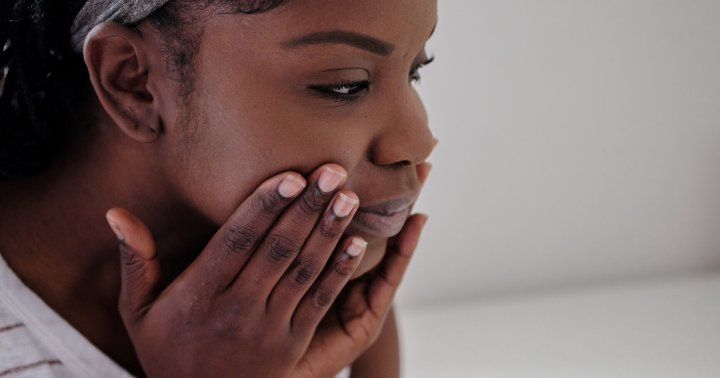














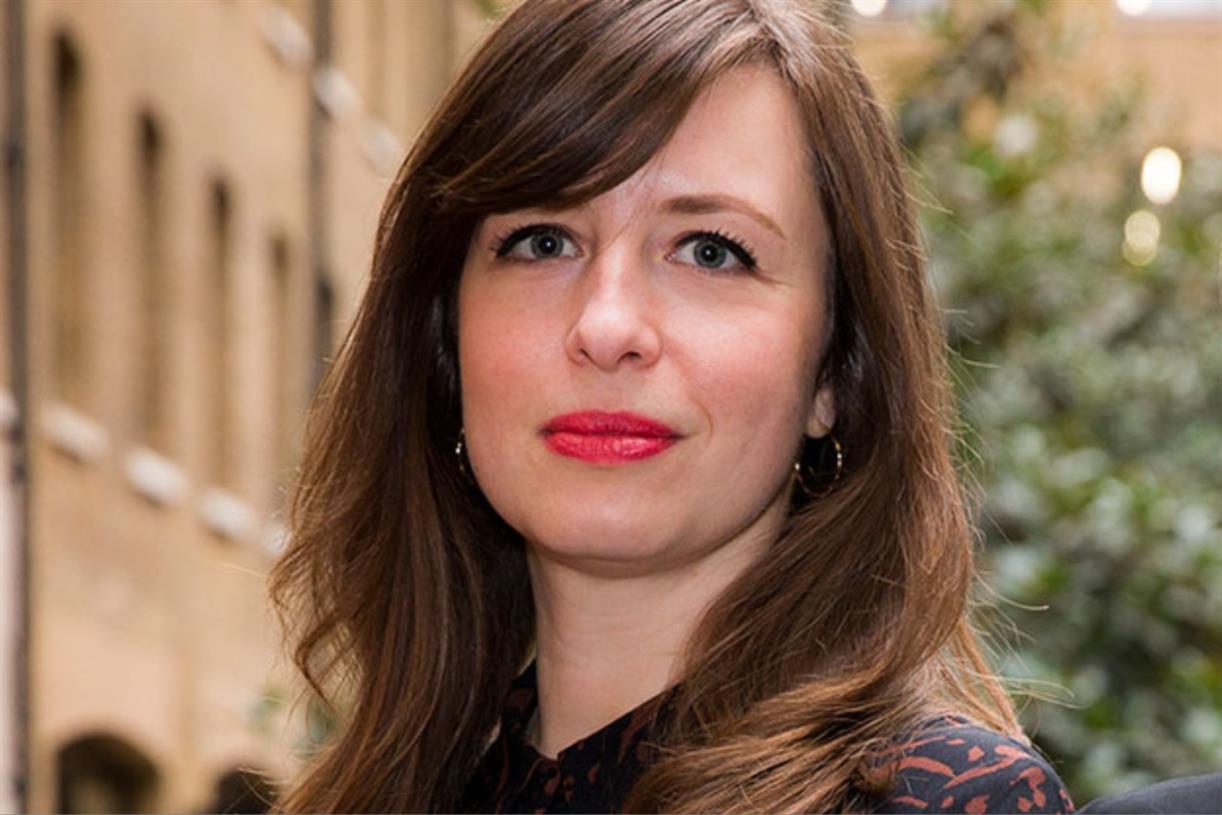
.jpg&h=630&w=1200&q=100&v=f776164e2b&c=1)

